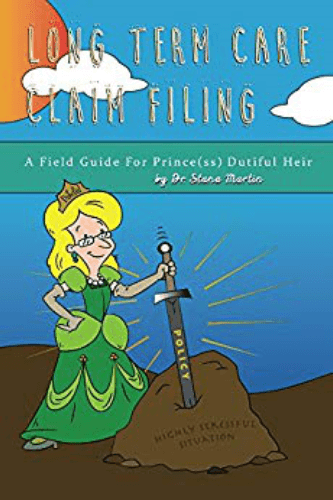What is the difference between medical insurance and long term care insurance?
Medical insurance covers current medical expenses such as prescriptions and doctors’ visits. The aim if it is to pay for short term or recovery-based care. Long Term Care (LTC) insurance picks up where medical coverage leaves off. If person has a type of care that does not appear to be “getting better” (think Dementia, Stroke, broken hip in old age, accidents that cause paralysis, or a long fight against cancer), medical insurance won’t cover the care giving (it still covers doctor and Rx – just not the care giver!). Long term care services can include home care, assisted living, nursing care and limited prescription costs.
The Affordable Health Care Act (commonly known as Obama Care) is primarily medical insurance.
Who should purchase Long Term Care Insurance?
Frankly, this product is not right for everyone.
In general, you SHOULD look into it IF:
- Your age is between 40 and 70 – younger is cheaper. Very few folks over 70 will pass health screening,
- You are still in good health — again, youth is to your advantage here. Younger is healthier and healthier is cheaper. It is possible to be uninsurable on these products.
- You have assets to protect – You should have at least 50K to 70K (not counting equity in your home). If you have that level of assets to protect or more, then this is a smart financial move to look into.
If you meet all three of these criteria, then you are wise to be looking into this product.
What do LTC Policy’s cover?
Most long term care policies pay for care in your home, in assisted living facilities, adult day care and nursing homes. You should be looking at a “comprehensive” policy – one that covers all those types of care and leaves you in the driver’s seat on choice of care. It pays for both home care services (such as companionship, light housekeeping and aide services for dressing or showering) and for skilled care services (medical care such as nursing or therapy).
If you hunt, you can still find a “nursing home only” policy and it will be cheaper than a comprehensive long term care insurance policy. But given that most people really don’t want to be in a nursing home, you would be wiser to pay the extra to have the full range of care.
What should I look for in a company?
Get a good company – ask about financial ratings (you want a top drawer company!), history of price hikes (good companies have had less than 3 price raises in a 25 year history of offering this product), how well do they pay claim and pattern of complaints filed with the Insurance Commissioner (most states house a “complaint index” on the Insurance Commissioners page). None of these will guarantee that the company will never go under or will be easy to work with 30 years from now when you need to file a claim. But knowing that a company has a good track record now is your best indicator that they will be around and good in the future.
What if I do buy a policy and the company goes under?
Every state is required to have a State Guarantee Fund – this functions like the FDIC for banks. Every company that sells a long term care insurance policy in the state is required to commit some small portion of each dollar to the fund. Then, if any long term care insurance carrier goes belly up, policy holders can take their policy-in-good-standing (meaning premiums are still paid in full on it) and get value from the policy out of the fund.
All of this is in theory so far, by the way. To date no long term care carrier has gone under.
What are typical benefits in a policy?
The problem with this type of insurance is that it isn’t like anything else you have ever bought. There really is no typical. The policies are designed to be tailored to fit you like a fine suit in terms of size and features. To see a full discussion of these, you may want to read further on [ Benefits for spouses ], [non-traditional couples and benefits] , [my family has history of cancer], [what if I die and never use it], and [how to shorten the deductible, aka “elimination period”].
There are 4 basic benefits that ever policy owner will need to understand and make a decision about what fits them.
BASIC BUILDING BLOCKS
Benefit amount — how much the policy will pay each day or month for care. Very few people will buy 100% of the current cost on this item. Most people will have the policy pay between 50% of the cost and 80% of current cost – figuring they can co-insure some of the cost. This is an item where you MUST deal with the way inflation will drive costs up. If, for instance you opt to pay $1000/month of the cost today, 15 years from now everything will have doubled….including your co-insurance amount. Good agents should be able to help you estimate this and get a better feel for it.
- Time multiplier — typically in the form of years (2 years, 5 years, 6 years, etc.). SOME policies this time will actually be a clock or a set time window of payment. But MOST policies today operate from a bucket of money concept. The total pool of money in your policy is figured by multiplying your daily/monthly amount by the time multiplier. So a policy that pays $200/day for 3 years will have a total pool of money of $219,000. If you use the full daily amount from the first day of care, the policy will pay out exactly 3 years – it divides out, after all the same way it multiplied together. BUT…if you use only half the amount (say $100), then your policy could last 6 years.
- Deductible – the true vocabulary here is “Elimination Period”. It is the number of days you pay for care out of your own pocket before the policy will pay. Choices are usually 30, 60 or 90 days, though you will occasionally see 120 or 180 days. Be cautious of longer deductibles. They may look good in theory, but they often don’t cost out: your savings in premium isn’t worth the extra you would pay in cost of care.
- Inflation protection – Choices are usually simple, compound or CPI. The younger you are when you buy, the more you need compound. There may be other variations such as CPI +1 or GPO or FPO. Be sure you understand how the inflation rider works and how it will grow your benefit over time. Agents and companies are required to provide you with an illustration before or at the time your purchase. If you make the mistake of getting the wrong kind of inflation, it could seriously impact how much you pay out of pocket 15 to 30 years from now.
Are there any benefits useful to spouses?
Generally there are two benefits that are available to persons who are in a committed relationship and sharing expenses [see info on non-traditional couples for more details about who can qualify for this].
1) Shared Care– this is a feature where you can tie two separate policies together. Typically person A has a bucket of money in a policy and person B has the same. When you add this feature, it means that if A goes into care and drinks his/her bucket of money dry, you can opt to drink from B’s policy. This doesn’t happen very often. More typically A will pass away with money in his/her bucket (because other person provided a lot of “free” care, typically). In this scenario B, the last spouse standing, inherits what was left of A’s policy. Since B will often have a larger outlay of money for care, this is often a wise addition to a policy. However, it will add to the cost.
2) Survivorship – this feature says if you own your policy for a minimum window of time without a claim (usually 10 years – but check the contract!) and THEN one of you passes away, the surviving spouse’s policy is paid for in full. This is usually valuable to couples where one of them has a strong pension that is likely to disappear when that person dies. Military couples, railroad retirees and others with pensions should consider this if there is a risk that the surviving spouse could have some cash flow problems if pension-person dies first.
Non-traditional couples and benefits on long term care
Most policies today are not requiring a legal marriage for two persons to be considered a couple or to be care partners for each other as they age. Even if the state where you reside does not recognize your situation, it typically won’t matter to the insurance carrier. Some carriers even recognize siblings who live together and share expenses to be valid for couples discounts and other couple benefits.
Cancer and long term care
The incidence of cancer continues to rise in the USA today. As treatments become more aggressive and science allows us to treat situations that previously were terminal, we are seeing more people making claims at young ages (say in their 40s and 50s) because they need help due to the effects of chemo, radiation or even just the progressive debilitating nature of cancer that is not treatable. If you have a high incidence of cancer in your family (or if this is a concern for you), there are a couple of benefits you should consider:
1) Waiver of your elimination period for home care – this is usually abbreviated “Waiver HHC”. Essentially it means that when you make a claim in home health care, there is no elimination period or deductible window; the policy will pay on first day of home care. Since most cancer patients will be care for in the home rather than in a nursing home, this feature can truly mean the difference for a family managing care.
2) Restoration – this is a feature that says if you use your policy and “drink” the bucket of money down (say you have 6 months of care due to heavy chemo and radiation treatment), but then you get better and no longer need care, the company will top your bucket of money back up to the full amount. In short they “restore” the full amount once you go off claim. Restoration is most commonly bought by younger buyers because they have a more likely chance of using it some time in their ownership. Folks at age 70 and up – well, if they go down far enough to need care, statistically they rarely get better enough to go off care. For that age bracket it is usually the “beginning of the end”. So the recommendation is to purchase this feature if you are either young when you buy and/or if you have a high incidence of cancer in your family tree.
What if I never use it?
This is a very common concern people have. This is not the cheapest type of insurance you will buy – still whenever anyone asks me I always wonder to myself if anyone buys insurance saying, ‘Man! I hope I USE it!’ Nevertheless, there are some logic answers that may help you.
Here are just two:
1) Consider a hybrid or combo product – these are built on a life insurance or annuity chassis and if you never need care, then there is a death benefit or asset that can pass to heirs or beneficiary. These are not for everyone, however. See the more complete discussion at {insert link here to other place}
2) Consider that the data is not in your favor – Federal stats indicate 70% of us will be in care before we die if we live to age 65+. So you have a 30% chance that the answer to this question is “yep, you won’t ever use it”. Insurance is a risk management tool. You must decide how much you are willing to risk on the 30% chance you won’t use it. When we counsel people around here it pretty much boils down to which mistake they want to live with. Which mistake can I live with?
Questions?
Contact - Mrs. LTC
Long Term Care Claims & Insurance
816-222-4551
Email
Free Consultation








Leave A Comment
You must be logged in to post a comment.